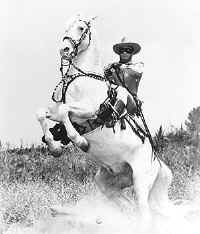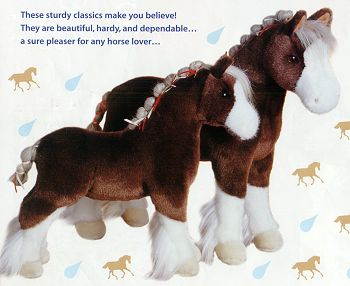|
|
When you can stay relaxed over the horse’s center of
gravity, you are in balance. When you are in balance, you can
stay on the horse.
Riding Tree: Balance
by Faith Meredith
When a student gets on a horse to take that first riding lesson,
their greatest concern is staying there. Everyone is afraid of
falling off, particularly in the beginning. Whether you are the
student or whether you are the instructor, you need to be aware
of this fear and aware that it is very normal.
Fear of falling creates both mental and physical tension. That’s
why relaxation is at the base of the riding tree, the set of
skills a rider needs to master in order to develop an independent
seat. In order to relax, you have to become aware of every part
of your body--every muscle, every joint--and find any places
where you are holding tension. When you can let go of all of this
involuntary tension, you can move to the second level of the
riding tree. When you can stay relaxed over the horse’s center of
gravity, you are in balance. When you are in balance, you can
stay on the horse.
Essentially, the horse’s center of gravity is right where you
sit. If you are gripping with your calves or gripping with your
thighs or hanging on the reins in order to stay there, you are
not balanced. Good balance requires both being relaxed and being
centered. You need both vertical balance and side-to-side
balance.
The vertical balance refers to the position of your upper body.
When you are vertically balanced you are not tipping too far
forward and you are not leaning too far back. Side-to-side
balance means that you have even pressure on both seat bones. You
are not leaning or falling off to the left side or to the right
side.
Lone Ranger and Silver

You need to use your muscles correctly in order to maintain this
centered alignment over the horse’s center of gravity. Using your
muscles correctly means tensing the right muscle groups to help
keep your body stabilized over the horse’s center of gravity but
this is an “athletic” muscle tension rather than the nervous
muscle tension that destroys relaxation. The primary muscle
groups that you use to maintain alignment or balance are your
upper and lower abdominal muscles.
Remember that balance is an issue for the horse, too. Depending
on where the horse is in his progressive training the horse may
be learning how to carry himself and the weight of the rider
while staying balanced. When you balance quietly over the horse’s
center of gravity, you help him stay balanced. If you lose your
balance, you will throw the horse off balance, too.
Becoming aware of how your body is aligned will help you develop
better balance. Riding instructors preach to beginning students
about lining up the elbow, the hip, and the ankle so that
everything drops straight down. If your feet are stuck straight
out in front of you, your upper body is going to come back behind
the motion of the horse. If your legs are too far behind you,
your upper body is going to go in front of the motion of the
horse. When the horse feels this, he wants to correct it.
If you fall behind the motion, horses will do one of two things.
They will either run forward or they will slow down, perhaps even
stop, as they try to position you back over their center of
gravity where it feels comfortable for them to carry your weight.
As your body stays relaxed and centered over the horse’s center
of gravity, its alignment may change depending on the horse’s
direction, speed, and gait. This is particularly true when you
finally reach the higher levels of any riding sport. As her horse
leaves the ground in front of a jump, for example, the jumper
rider’s upper body folds forward because she must realign her
body to stay over the horse’s center of gravity. In the same way,
a cutting horse rider may sit heavier on one seat bone as his
horse changes direction or a reining horse rider may put
burdening weight on both seat bones as his horse does a sliding
stop. They are realigning their bodies to stay over the horse’s
center of gravity and remain in balance as the horses shift their
own balance in order to perform at higher levels.
Understanding the riding tree helps you build a solid foundation,
an independent seat that will take you into the higher levels of
whatever riding discipline you choose to pursue. When you are
relaxed and balanced, you can begin to work on following the
horse’s motion at the walk, trot and canter. Your communication
with your horse moves to a new level. Then you can begin to apply
the aids in ways that ask the horse for specific shapes. As your
communication with the horse improves, you will begin paying
attention to rhythm and timing, coordinating the aids for greater
precision. Finally, instead of just asking for what the horse
already knows, you will be able to start influencing the horse,
teaching him new shapes and new games.
© 2001-2004 Meredith Manor International Equestrian Centre.
http://www.meredithmanor.com/
Stuffed Horses - Excellent 4 Gift Ideas!

Happy Horse Riding Calendars
|